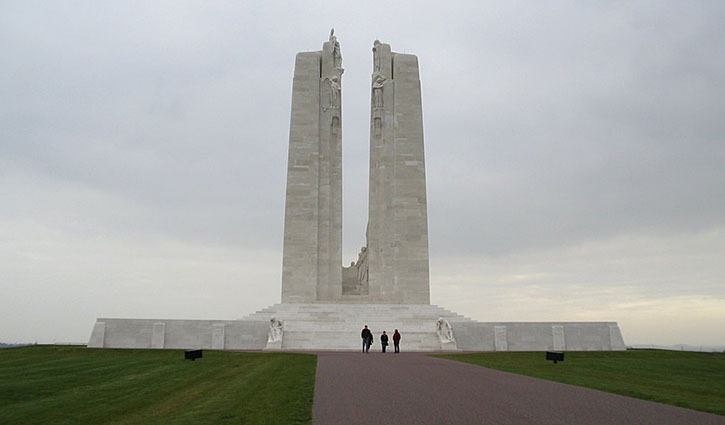The word conjures images of blood and death. Of men caught in barbed wire and mowed down by machine-gun fire. Of the horror and senselessness of war.
But for many Canadians it also sparks a fierce sense of nationalism. It’s the moment, they say, when Canada was born – or at least came of age as a country.
On Sunday morning, millions of Canadians will stop for a moment to remember those lost during the Battle of Vimy Ridge.
Some will gather around the soaring white monument erected on the high point that thousands of Canadians – farmers, miners, teachers and lawyers – had fought and died to capture exactly 100 years ago.
They will stand with Prime Minister Justin Trudeau and other dignitaries, including Prince Charles and sons William and Harry, amid the mournful skirl of a lone bagpiper and a children’s choir singing “In Flanders Fields.”
Millions more will listen to the two-hour ceremony on their radios or watch on their televisions, or bow their heads at similar events at local monuments inscribed with the names of the dead.
Many like Toronto businessman Drew Hamblin, who will spend Sunday at Vimy with his father and two children, had grandfathers who told them about the rain and the cold and the rat-infested tunnels.
“I got to see how it affected my grandfather,” Hamblin said. “And he, in turn, passed it on to me. We were inseparable when I was a kid, and this is my way of honouring him and everyone who fought with him.”
Others have only sepia-toned photographs or letters and diaries to remember great uncles and distant cousins who were among the 10,500 Canadians killed or wounded during the four-day battle for the ridge.
And then there will be those for whom the connection to Vimy will be more symbolic, a recognition of the individual sacrifices and what they did for Canada and the world.
There is a fierce debate over the actual importance of the Battle of Vimy Ridge.
The battle marked the first time all four Canadian divisions fought together side-by-side during the war, advancing together into the sleet and bullets and bombs on April 9, 1917: Easter Monday.
Not only did the Canadians succeed where the English and French had failed by capturing the strategically important ridge from the Germans, they did it with several innovative approaches to warfare.
“It was important just as a symbol of bringing everyone together,” said Jeremy Diamond, president of the Vimy Foundation, the mission of which is to promote and preserve Canada’s First World War legacy.
“There’s a sense of accomplishment of what we did.”
In 1936, as Canadians and many others around the world watched the Vimy monument’s unveiling, retired brigadier-general Alexander Ross famously intoned that the battle had marked “the birth of a nation.”
But it wasn’t the largest battle that the Canadians fought in the First World War. The Somme and Passchendaele were bloodier. And even those who fought there said it wasn’t the most important.
“We fought other battles where the moral and material results were greater and more far reaching than Vimy’s victory,” Canada’s greatest First World War general, Sir Arthur Curry, said in April 1922.
“It did not call for the same degree of resource and initiative that were displayed in any of the three great battles of the last hundred days: Amiens, Arras, Cambrai.”
The battle doesn’t even have the distinction of being the first with a Canadian in command of the Canadian Corps. That would come four months later, at Hill 70, when the Canadians fought under Currie.
Vimy also wasn’t the first choice for Canada’s First World War memorial. That was Ypres, Belgium, until the British built their national memorial there. Vimy was the next best location because of its accessibility.
As for unity, there are those who say Vimy actually exacerbated divisions between English-Canada, which supported the war, and French-Canada, which opposed it, by pushing the country closer to conscription.
Those who herald the importance of Vimy acknowledge all this, but say it is what Vimy has come to represent over the years and decades that matters.
For Gov.-Gen. David Johnston, it is the way the battle was fought, with commanders trusting their troops and thinking about warfare differently, that he believes is reflective of what sets Canada apart today.
“All of those were things that I think came to mark Canadians not only as warriors,” he says, “but to some degree how we carry out our day-to-day affairs.”
For others, Vimy represents Canada’s transformation from a British colony to a country confident of its place in the world and worthy of other’s respect — what some call its coming of age as a nation.
“Vimy is often shorthand for the First World War,” says military historian and author Tim Cook, whose most recent book is entitled “Vimy: The Battle and the Legend.”
“We did emerge as a different country coming out of the First World War. Sixty-six thousand dead. A country that had stepped up. A country that was nearly torn apart. We’re never the same after the First World War.”
But Vimy’s real importance and power appears to be in the fact that many Canadians believe it is important, which is why they will watch and listen as the country looks back in time.
“Every society, every group has its own myths, symbols, explanations for where they came from,” says Queen’s University history professor Allan English.
“Symbols are just shorthand for something that’s really much more complicated. So Vimy has over time become the symbol of a birth of a nation.
“Even though you can deconstruct it, it’s become that.”
Lee Berthiaume, The Canadian Press
